In this article, we will talk about one of the components of strategy building in poker, namely: position.
We will answer the following questions:
- What is its importance exactly?
- How does it affect bet sizing choices?
- Whether the choice of betting hands depends on our position?
- What mistakes players make while being in position?
First, let’s start with general picture of what variables make correct poker strategy:

No matter how many players are at the table, we will always be in situations where we either in position or out of position. In addition to position, there are other important variables:
Initiative
The last player to take aggressive action does have initiative, which by default implies a stronger preflop range, since other player would most likely take aggressive action with his strongest hands. The less preflop raises there were, the more obvious this theory is (single-raise pots, iso-pots, 3bet pots).
Range
Polar: In this case, the difference in equity between top and bottom parts of our range is huge:
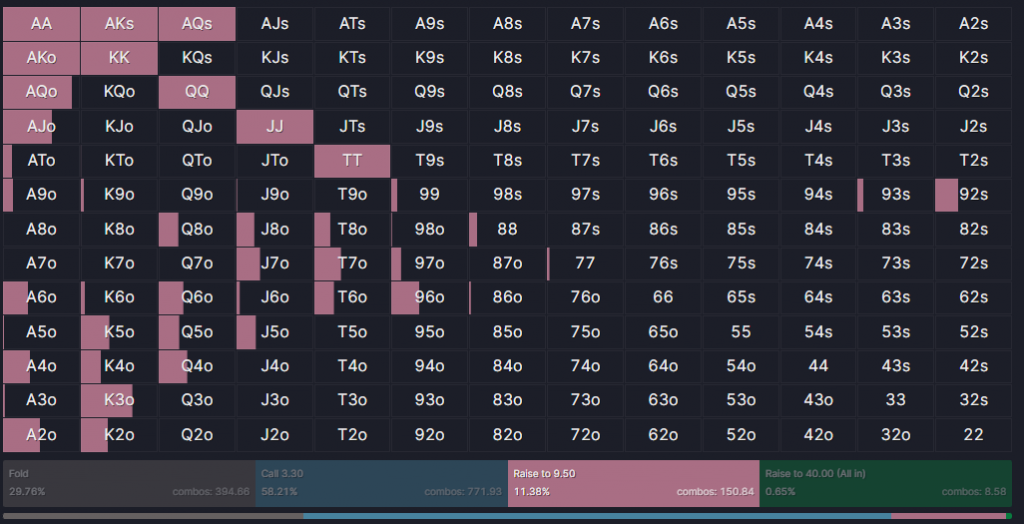
Linear: Equity of hands goes down gradually from top to bottom hands of the range. No big equity jumps between hands:

Equity
The equity of a range often depends on range’s composition, but there is a very important factor as well, which is equity realization. Two ranges may have the exact same equity against opponent’s range, but polar range would realize its equity worse than linear range, since all those mid connectors and suited hands have more opportunity of catching some decent hand or draw, which allows realizing more equity. Hence, the EV of hands like that is correspondingly higher and the range with those hands brings more profit.
Position
Player in position always has better equity realization, because acting last gives us a number of advantages:
- He makes decision after he sees what his opponent did;
- An ability to control the pot size;
- Favorable conditions for bluffing;
- The possibility of unerring slowplay*
*When we play out of position and want to lure a bet from our opponent by checking, then if our opponent checks back we lose huge part of our expectation. In position, on the other hand, we always act last
Let’s take a situation from a full-table MTT where BU opens 2bb and BB calls 40bb effective.
Postflop ranges look like this:
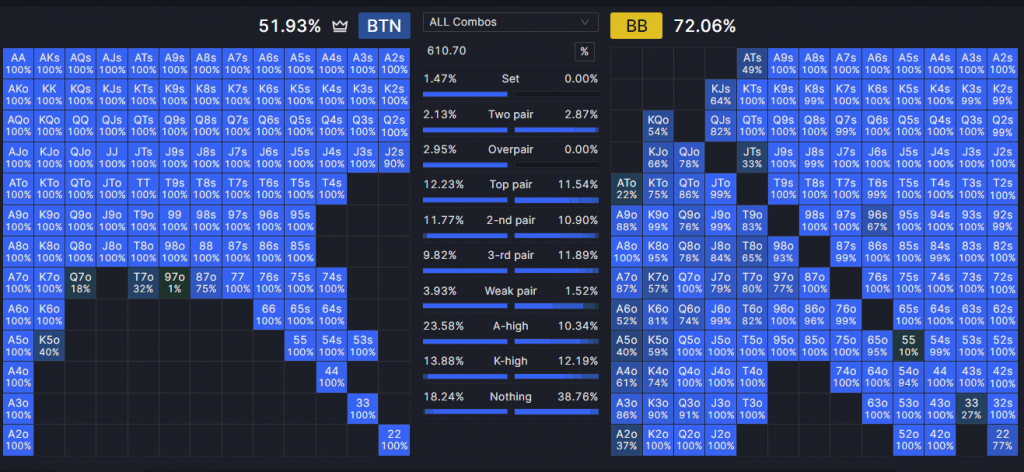
This way, BU will play in position and with an equity advantage on most textures.
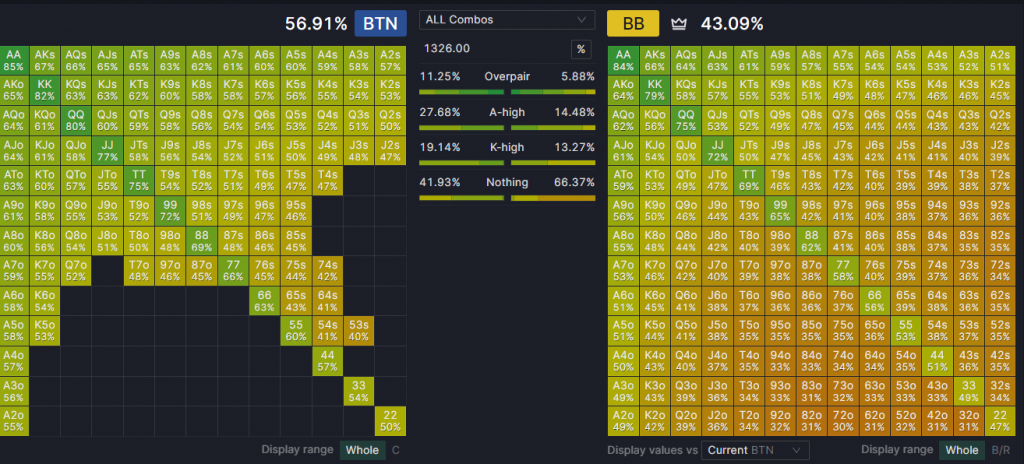
Now I would like to figure out how all of this would affect the equity realization of both players. Based on the report data for all textures (in the app, you can go to the viewer tab in reports-agg.runouts), we can see the players’ equity realization differs significantly and BU is a clear favorite across the board. I think now it is not difficult for us to determine which of the players has an incentive to rack up the pot by the river, and who, on the contrary, wants to minimize the potential losses.

With this equity realization on BB, we should be really careful about calling bets on flops and turns, relying basically on pot odds only, because on most textures our hand realizes less than 100% of its equity. If, for example, we 50% equity of flop, in reality we will realize only 50% * 0.76 = 38%.
And this means we often have to give up hands with enough equity but poor realization on earlier streets already.
Let’s take this texture as an example:

BU cbets 1/3 pot and pay attention to BB’s reaction:

He defends 58.5% of his range, while having 20% pot odds, he prefers to fold hands like A2o-A5o, which currently have 35% equity and dominate villain’s bluffing range. The thing is that after calling it is not guaranteed that everyone checks down and we get to showdown, and every following bet from our opponent lowers our equity realization in a way that we actually lose 0.37bb by calling those hands on the flop.
At the same time, hands like 78o with 28% equity, on the contrary, get to our calling range with an expectation of 0.57bb.

It is important to understand how often your opponent is able to bet on the following streets. The higher the checkdown probability, the better the expectation of hands like A2o-A5o and the worse it is for hands like draws without showdown value.
Let’s say BB called the flop in a spot like we have here and then checked the turn (turn is 4s):

Now it’s time to figure out which hands and why BU prefers to use as a bet and ones as a check while in position. Since turn card bricked out and the texture did not change (apart from backdoor flush-draw potential), BU prefers to use a polar strategy: bets big all of his top pair plus combos, adding some bluffs, and checks with medium-strength hands to control the size of the pot and to catch opponent’s bluffs with hands he floated the flop and didn’t improve on turn and/or river.

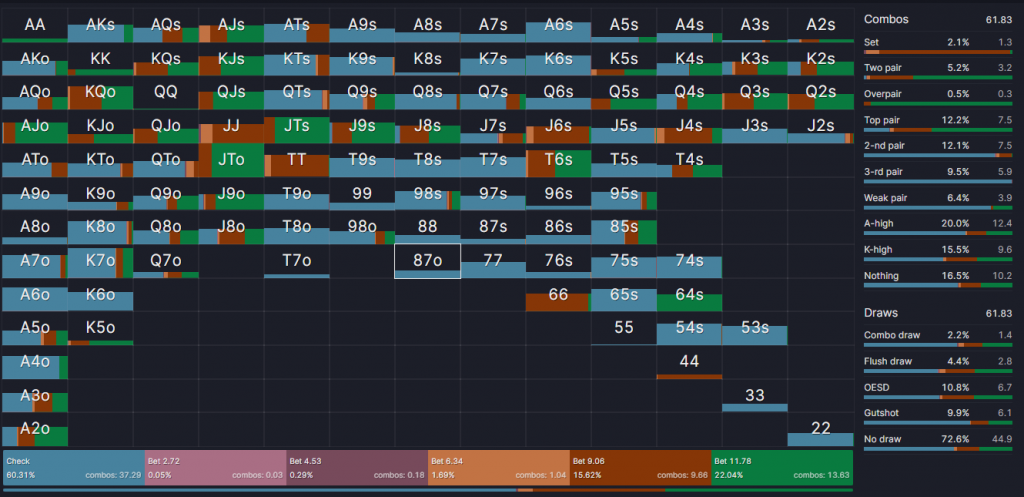
Let’s take a more detailed look at the bottom of the betting range.
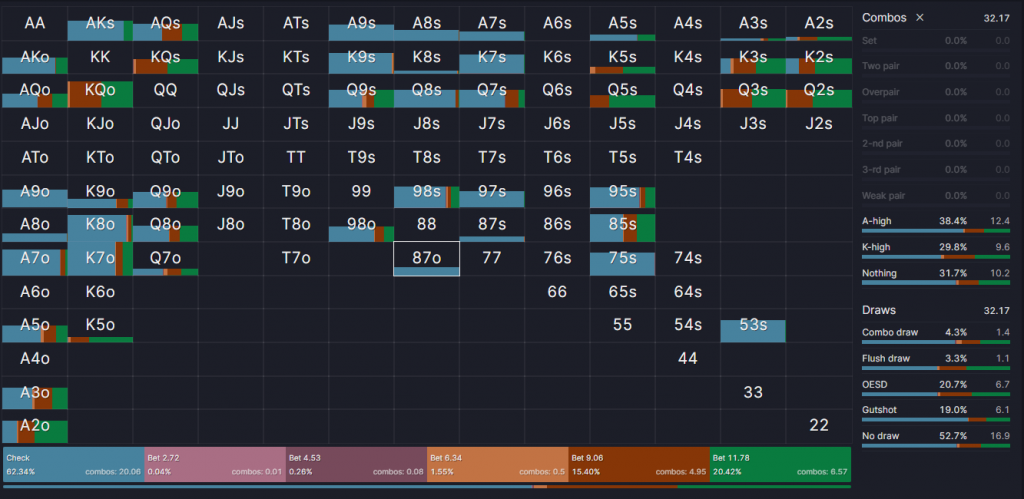
BU prefers to check his gutshots and weak OESD more often. This is because he can sacrifice his equity when faced with a turn raise; he can just fold and burn his equity. Therefore, for bluffing he chooses hands that are not afraid to fold against a raise and have some relevant blockers to opponent’s continuing range: A2o-A5o, K5o-K7o.
If we look at the EV difference between checking and other actions, we see that most of the hands from bluffing range either make more money by checking or have betting expectation similar to checking.
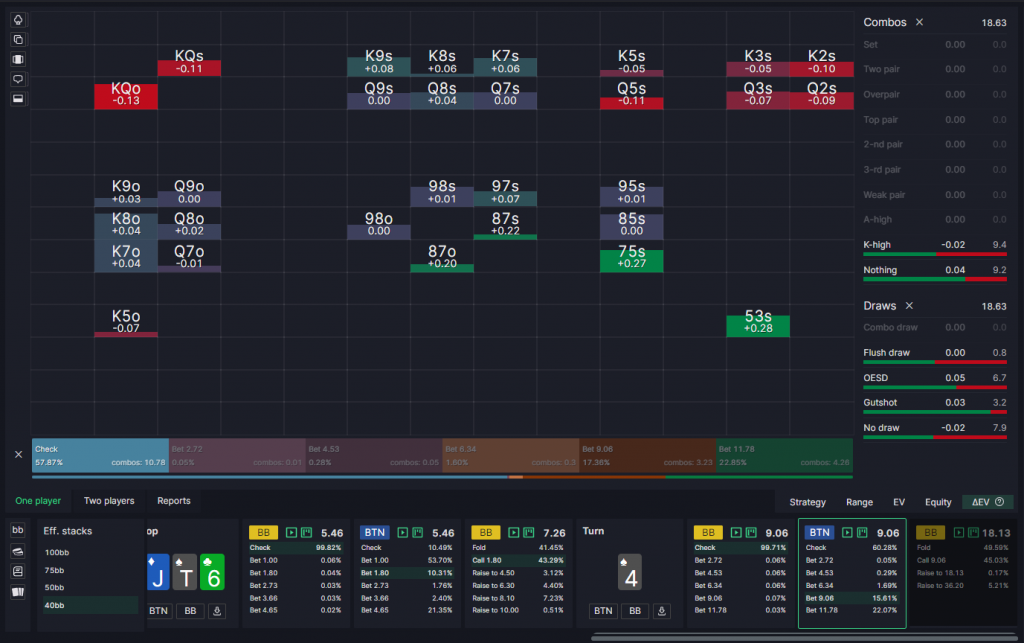
Therefore, on such textures, as a BU you should not rush to bluff all your drawing hands hoping for a positive expectation of such a strategy. It has its disadvantages, such as burning equity against a raise or blocking opponents call flop fold turn range.
Summing up, I’d like to say that although the position gives decent advantage, we should not abuse it. Because on one hand, it gives us good equity realization and potential to win more chips, but on the other hand, we can get carried away with this equity realization and play aggressively hands that really do not want to face a raise and otherwise have an opportunity to realize equity if opponent checks back.
If you have any questions about the content of the article or want to discuss it with other poker players, join our Discord Chat.

